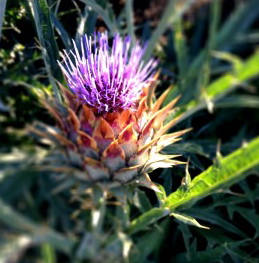Help map the spread of invasive plants with a smartphone app

If you have a sharp eye for invasive plants – and a smartphone – you can help a Bay Area non-profit in its effort to document the distribution and spread of invasive plants across California.
The Berkeley-based California Invasive Plant Council, or Cal-IPC, has found that weeds cost the state at least $82 million annually in terms of increased erosion and flooding, degraded agricultural land and reduced water supplies.
California is hardly alone. A 2005 study by researchers from Cornell University put the nationwide cost of battling invasive weeds at a staggering $120 billion [PDF].
Climate change is making the issue even more complex, says Doug Johnson, Cal-IPC’s executive director, who is trying to better understand how non-native plants may respond and how they may gain advantage over native plants during prolonged bouts of warming or cooling.
“It’s not as simple as saying climate change is going to make everything worse in terms of invasives,” Johnson told me. “But in general, invasive species are generalists and are able to outcompete native plants. They also tend to thrive on disturbance, so a change in conditions that may impact other species more harshly may end up favoring invasives.”
In order to keep track of California’s weeds, and, more importantly, where they’re spreading, Cal-IPC has worked with state and local experts to evaluate a list of invasive and noxious plants.
“We went through those plants, looking through all the quadrangles of various counties or regions and decided how generally abundant they are, whether they are spreading and if they are under management,” said Johnson.
With the data compiled, the group built an interactive, public site called CalWeedMapper, which uses a mosaic of 7.5-minute quadrangle tiles (covering an area of roughly six by eight miles). Though the map’s resolution is still very “coarse,” according to Johnson, the group has begun to harness the collective power of thousands of smartphone-wielding amateur botanists. Mountain bikers in Mendocino, say, or hikers in the Alabama Hills on the east slopes of Mount Whitney can take note of invasive plants and upload their locations to CalWeedMapper by way of a smartphone app called Observer.
The site is tied in with two other large databases operated by the Consortium of California Herbaria and Calflora, which, Johnson says, enhance the precision and reach of the group’s citizen mapping effort.
The effort comes at an opportune time, particularly with so many fires burning across the state and the West. Cal-IPC is particularly concerned with so-called “fire followers,” invasive plants such as cheatgrass, star thistle, knapweed and scotch broom that tend to expand their range as fires scour the land.
“With climate change, one of our main areas of concern is the Sierra. As temperatures warm, invasive species may be able to move up in elevation,” said Johnson. “There are also rangeland species from Plains states, which are often brought in [inadvertently] on heavy equipment and can take off in areas cleared by fire.”
If you are interested in helping Cal-IPC in its weed-plotting effort – and in downloading the Observer smartphone app – you must first register with CalFlora.
4 thoughts on “Tapping Crowds to Track California’s Weeds”
Comments are closed.


Very cool. Nice job you guys.
There were some interesting comments here that seem to have been removed.
For instance, Charlie Hahn wrote a comment mentioning the What’s
Invasive and iNaturalist phone apps. These are fine– Calflora picks up
feeds from both of these projects, so if you contribute a weed
observation from either one, it will make it to Calflora and on to
Cal-IPC (as well as to other folks who monitor weeds).
The other point is that if you want to help Cal-IPC track weeds, you don’t need a smartphone. You can also contribute a weed observation directly from the web app:
http://www.calflora.org/entry/wentry.html
We’re not sure what you might’ve seen, John. We did not remove any comments from this queue. We will occasionally remove comments that are abusive, off-point or clearly spam but that was not the case here. We do appreciate you sharing this info, though!
More on this: We did some snooping around under the hood and it does appear that some kind of software glitch has been playing mischief with some of our comments. We’re attempting to locate and restore what we can, and of course, fix the bug. Thanks for bringing it to our attention.